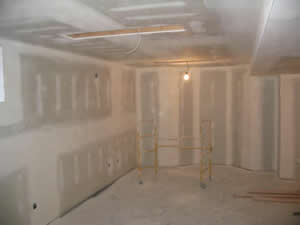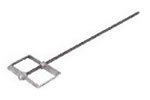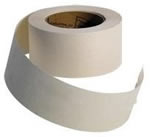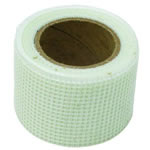One of the most difficult projects, to create a professional finish, faced by most home handymen is taping drywall or sheetrock, as shown in Figure 1. We have all watched professionals on TV tape walls and apply drywall compound in minutes, a few quick passes with a drywall knife or trowel a quick sanding and the job is complete. Yet, we buy good tools and stand in front of the drywall knowing that getting a smooth finish is going to take us hours.

Figure 1 - Room drywall taped
The problem that most home handymen face, when taping drywall, is just a lack of experience. The TV experts
, have been doing it for years and if you did drywall taping for 5, 10, 15 or 20 years, 5 days a week, you too would be an expert!
There are tricks to the trade, things that you should or shouldn’t do, that will make taping the drywall easier and create a better finish.
- The drywall must be properly fastened and flat.
- Drywall joint compound (mud)
Before you start your taping project ensure that the drywall is properly fastened to the studs or other structural support. If the drywall has spring on the edges, it will be almost impossible to properly tape it, because as you draw the drywall knife over the surface the drywall will move.
If there are damaged corners that protrude from the surface, they must be removed. Do not think that pieces of dangling drywall will be held in position by the tape and drywall mud!
All of the metal corner beads for the drywall outside corners should be in position and properly fastened over the corners of the drywall.
The fasteners, whether they are nails or screws must be below the surface of the drywall. There should be a slight dimple where the screw or nail head sits on the drywall, the paper should not be broken. Run your drywall knife over the surface of the drywall, if it hits the heads of fasteners; re-seat those fasteners so that they are below the surface of the drywall.
Most home handymen will purchase the premixed drywall compound. Most professionals use bags of the dry drywall compound and mix it with water. If you use the premixed drywall compound you must do two things before you can use it:
- You must thoroughly mix the compound. It is almost impossible to mix a bucket of drywall compound using a piece of wood or other stir stick. You should mix the drywall compound using an electric drill and a mixing paddle, as shown in Figure 2. You want the speed of the drill to be very slow, so that you do not get air bubbles in the mixture.

Figure 2 - Drywall joint compound mixer
- You will most likely have to add some water. The premixed drywall compounds are generally too stiff to use, even when mixed thoroughly. The consistency should be similar to a creamy mayonnaise and the mixture must be lump free. The drywall compound should be mixed ever 20 to 30 minutes while you are taping.
- Put the lid back on the bucket of drywall compound when you have taken some out. If you are using the dry compound, place a damp towel over the bucket. This will help to avoid having the edges of the compound dry and create pieces of compound which will end up on the edge of the drywall knife or trowel and scratch the newly applied drywall compound.
If the drywall compound is too dry or stiff, it will not absorb into the paper tape and the paper tape will not seat itself properly in the drywall compound. This is one of the biggest problems that home handymen face when taping.

Figure 3 - Paper drywall tape

Figure 4 - Mesh drywall tape
- Drywall tape
You will find two types of drywall tape. The first is made from paper and will have a fold line running down its entire length, as shown in Figure 3. The second is a mesh tape, as shown in Figure 4, in many cases the mesh tape is self adhesive.
In my opinion, it is easier to use the paper tape than the mesh tape. The mesh tape is thicker than the paper tape and makes it more difficult to feather out the edges. I also find that as the mesh tape is usually placed on the drywall before adding any drywall compound, you do not obtain the same smooth finish as the tape has a tendency to buckle inwards. You will never see a professional using the mesh tape or any other “home handyman” tape product other than the basic paper tape.
